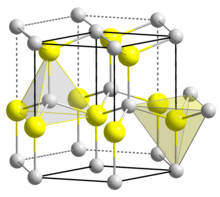Our website is made possible by displaying online advertisements to our visitors.
Please consider supporting us by disabling your ad blocker.
Beryllium oxide
 | |
 | |
| Names | |
|---|---|
| Preferred IUPAC name
Beryllium(II) monoxide | |
| Systematic IUPAC name
Oxoberyllium | |
| Other names
Beryllia, Thermalox, Bromellite, Thermalox 995.[1]
| |
| Identifiers | |
3D model (JSmol)
|
|
| 3902801 | |
| ChEBI | |
| ChemSpider | |
| ECHA InfoCard | 100.013.758 |
| EC Number |
|
| MeSH | beryllium+oxide |
PubChem CID
|
|
| RTECS number |
|
| UNII | |
| UN number | 1566 |
CompTox Dashboard (EPA)
|
|
| |
| |
| Properties | |
| BeO | |
| Molar mass | 25.011 g·mol−1 |
| Appearance | Colourless, vitreous crystals |
| Odor | Odourless |
| Density | 3.01 g/cm3[2] |
| Melting point | 2,578 °C (4,672 °F; 2,851 K)[2] |
| Band gap | 10.6 eV[3] |
| −11.9·10−6 cm3/mol[4] | |
| Thermal conductivity | 210 W/(m·K)[5] |
Refractive index (nD)
|
n11.7184, n2=1.733[6][7] |
| Structure[8] | |
| Hexagonal, zincite | |
| P63mc | |
| C6v | |
a = 2.6979 Å, c = 4.3772 Å
| |
Formula units (Z)
|
2 |
| Linear | |
| Thermochemistry[9] | |
Heat capacity (C)
|
25.6 J/(K·mol) |
Std molar
entropy (S⦵298) |
13.77±0.04 J/(K·mol) |
Std enthalpy of
formation (ΔfH⦵298) |
−609.4±2.5 kJ/mol |
Gibbs free energy (ΔfG⦵)
|
−580.1 kJ/mol |
Enthalpy of fusion (ΔfH⦵fus)
|
86 kJ/mol |
| Hazards | |
| Occupational safety and health (OHS/OSH): | |
Main hazards
|
Very toxic, Group 1B carcinogen |
| GHS labelling: | |
  
| |
| Danger | |
| H301, H315, H317, H319, H330, H335, H350, H372 | |
| P201, P260, P280, P284, P301+P310, P305+P351+P338 | |
| NFPA 704 (fire diamond) | |
| Lethal dose or concentration (LD, LC): | |
LD50 (median dose)
|
15 mg/kg (mouse, oral)[11] |
| NIOSH (US health exposure limits): | |
PEL (Permissible)
|
TWA 0.002 mg/m3 C 0.005 mg/m3 (30 minutes), with a maximum peak of 0.025 mg/m3 (as Be)[10] |
REL (Recommended)
|
Ca C 0.0005 mg/m3 (as Be)[10] |
IDLH (Immediate danger)
|
Ca [4 mg/m3 (as Be)][10] |
| Related compounds | |
Other anions
|
Beryllium telluride |
Other cations
|
|
| Supplementary data page | |
| Beryllium oxide (data page) | |
Except where otherwise noted, data are given for materials in their standard state (at 25 °C [77 °F], 100 kPa).
| |
Beryllium oxide (BeO), also known as beryllia, is an inorganic compound with the formula BeO. This colourless solid is an electrical insulator with a higher thermal conductivity than any other non-metal except diamond, and exceeds that of most metals.[12] As an amorphous solid, beryllium oxide is white. Its high melting point leads to its use as a refractory material.[13] It occurs in nature as the mineral bromellite. Historically and in materials science, beryllium oxide was called glucina or glucinium oxide, owing to its sweet taste.
- ^ "beryllium oxide – Compound Summary". PubChem Compound. USA: National Center for Biotechnology Information. 27 March 2005. Identification and Related records. Retrieved 8 November 2011.
- ^ a b Haynes, p. 4.51
- ^ Ryu, Y. R.; Lee, T. S.; Lubguban, J. A.; Corman, A. B.; White, H. W.; Leem, J. H.; Han, M. S.; Park, Y. S.; Youn, C. J.; Kim, W. J. (2006). "Wide-band gap oxide alloy: BeZnO". Applied Physics Letters. 88 (5): 052103. Bibcode:2006ApPhL..88e2103R. doi:10.1063/1.2168040.
- ^ Haynes, p. 4.126
- ^ Haynes, p. 12.222
- ^ Haynes, p. 10.248
- ^ Bromellite Mineral Data. webmineral
- ^ Haynes, p. 4.139
- ^ Haynes, pp. 5.1, 5.6, 6.155
- ^ a b c NIOSH Pocket Guide to Chemical Hazards. "#0054". National Institute for Occupational Safety and Health (NIOSH).
- ^ Beryllium oxide toxicity
- ^ Greenwood, Norman N.; Earnshaw, Alan (1997). Chemistry of the Elements (2nd ed.). Butterworth-Heinemann. ISBN 978-0-08-037941-8.
- ^ Higgins, Raymond Aurelius (2006). Materials for Engineers and Technicians. Newnes. p. 301. ISBN 0-7506-6850-4.
Previous Page Next Page



